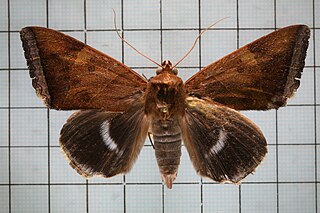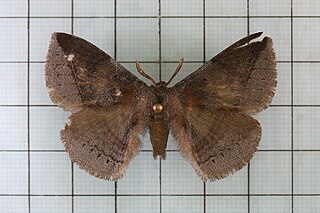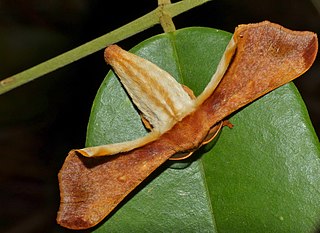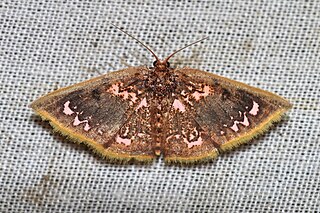
Bocula is a genus of moths in the family Erebidae. The genus was erected by Achille Guenée in 1852.

Aporandria is a monotypic moth genus in the family Geometridae described by Warren in 1894. Its single species, Aporandria specularia, was first described by Achille Guenée in 1857. It is found in Sri Lanka, India, Vietnam, Thailand, the Andamans, Peninsular Malaysia, Sumatra, Borneo, the Philippines and Sulawesi.

Hulodes caranea is a species of moth of the family Erebidae first described by Pieter Cramer in 1780. It is found from India, Sri Lanka, Myanmar, Java, Hong Kong to Queensland and New Guinea, it is also found on the Marianas and Carolines.
Bocula diasticta is a moth of the family Erebidae first described by George Hampson in 1926. It is found in Borneo.

Artena dotata is a species of moth of the family Erebidae. It is found from the Indian subregion to Sri Lanka, Taiwan, Japan, Sumatra and Borneo.

Trigonodes hyppasia, the triangles or semi-looper, is a moth in the family Erebidae. The species was first described by Pieter Cramer in 1779. It is largely cosmopolitan, found throughout Borneo, Fiji, India, Maldives, Nepal, Sri Lanka, São Tomé and Príncipe, Taiwan, Thailand, Zimbabwe, northern Australia, and almost all African countries.

Eucyclodes gavissima, the Oriental orange banded green geometer moth, is a species of moth of the family Geometridae described by Francis Walker in 1861. It is found in the Indian subregion, Sri Lanka, Bhutan, western China, Taiwan, Vietnam, Sumatra and Borneo.

Tridrepana albonotata is a moth of the family Drepanidae described by Frederic Moore in 1879. It is found in India, Nepal, Vietnam, Sri Lanka, Peninsular Malaysia, Sumatra, Borneo, Java, Bali and Sulawesi.

Sympis rufibasis is a moth of the family Noctuidae first described by Achille Guenée in 1852. It is found from the Indo-Australian tropics of India, Sri Lanka, Borneo east to New Guinea, the Solomons and Queensland.

Mnesiloba dentifascia is a moth of the family Geometridae first described by George Hampson in 1891. It is known from the Oriental tropics.

Ganisa postica is a moth of the family Eupterotidae described by Francis Walker in 1855. It is found in India, Myanmar, Sri Lanka and Taiwan.

Teulisna tumida is a species of moth of the family Erebidae first described by Francis Walker in 1862. It is found in Borneo, Sumatra, China, India, Sri Lanka, Thailand and Taiwan.

Gesonia obeditalis is a species of moth of the family Noctuidae first described by Francis Walker in 1859. It is found from eastern Africa, the Seychelles, the Maldives and the Oriental tropics of India, Myanmar, Sri Lanka east to the Philippines, the Sula Islands and Australia. The adult moth has brown wings with a scalloped dark brown band near the margin. The hindwings are similar in pattern to the forewings but are a paler shade of brown.
Scopula adeptaria is a moth of the family Geometridae. It was described by Francis Walker in 1861. It is found in Sri Lanka, India, Taiwan, Hainan, southern Myanmar, Peninsular Malaysia, Borneo, the Philippines, Sumba and northern Australia.

Bocula pallens is a moth of the family Erebidae first described by Frederic Moore in 1882. It is found in northern India, and Sri Lanka.

Gunda ochracea is a species of moth in the family Bombycidae. It was described by Francis Walker in 1862. It is found in the Indian subregion and from South-east Asia to Sumatra, Borneo and the Philippines. The habitat consists of various lowland forest types.
Zagiridia noctualis is a moth in the family Crambidae. It was described by George Hampson in 1897. It is found on Borneo and on Woodlark Island in Papua New Guinea.
Streptoperas luteata is a moth in the family Drepanidae. It was described by George Hampson in 1895. It is found in the north-eastern Himalayas and on Borneo, Sumatra, Java, Bali and Sulawesi.
Pseudojana pallidipennis is a moth in the family Eupterotidae. It was described by George Hampson in 1895. It is found in Myanmar and the north-eastern Himalayas.

Chrysocraspeda abhadraca is a species of moth in the family Geometridae described by Francis Walker in 1861. It is found in Indian subregion including India and Sri Lanka, Peninsular Malaysia, Sumatra and Borneo.















